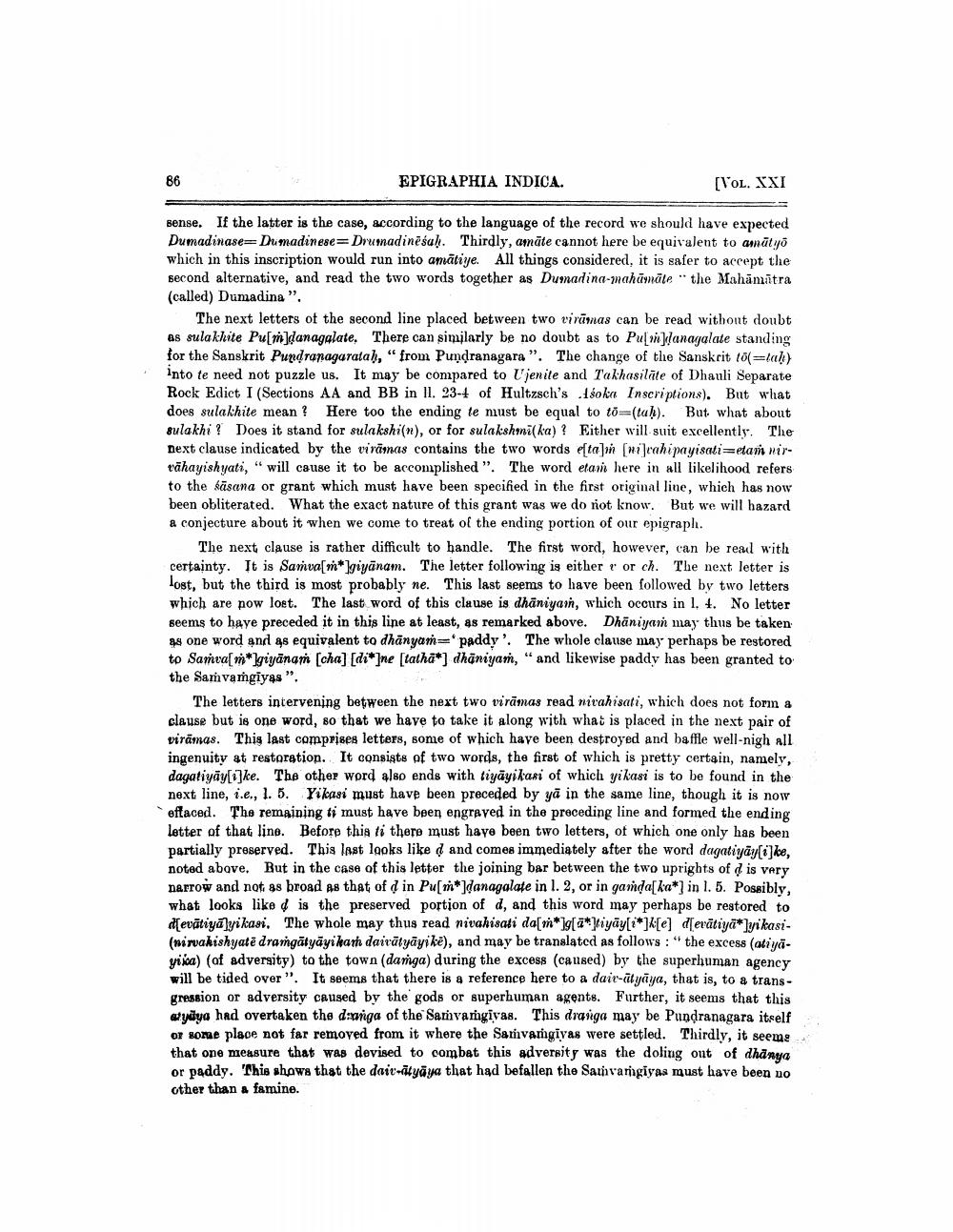________________
86
EPIGRAPHIA INDICA.
[Vol. XXI
sense. If the latter is the case, according to the language of the record we should have expected Dumadinase=Dumadinese=Drumadinēšah. Thirdly, amāte cannot here be equivalent to amātyö which in this inscription would run into amatiye. All things considered, it is safer to accept the second alternative, and read the two words together as Dumadina-mahūmāte " the Mahāmītra (called) Dumadina".
The next letters of the second line placed between two virāmas can be read without doubt as sula khite Pu[m]danagalate. There can similarly be no doubt as to Pu[mlanagalate standing for the Sanskrit Pundranagaratah," from Pundranagara". The change of the Sanskrit 10(=lah) into te need not puzzle us. It may be compared to U'jenite and Takhasilate of Dhauli Separate Rock Edict I (Sections AA and BB in 11. 23-4 of Hultzsch's 1soka Inscriptions). But what does sulakhite mean? Here too the ending te must be equal to totah). But what about sulakhi? Does it stand for sulakshi(n), or for sulakshmi(ka) ? Either will suit excellently. The next clause indicated by the virāmas contains the two words e{talın (wi Jeahipayisati=etan nirtähayishyati, "will cause it to be accomplished ". The word etani here in all likelihood refers to the sāsana or grant which must have been specified in the first original line, which has now been obliterated. What the exact nature of this grant was we do not know. But we will hazard a conjecture about it when we come to treat of the ending portion of our epigraph.
The next clause is rather difficult to handle. The first word, however, can be read with certainty. It is Sanva[*]giyānam. The letter following is either r or ch. The next letter is lost, but the third is most probably ne. This last seems to have been followed by two letters which are pow loet. The last word of this clause is dhāniyaın, which occurs in l. 4. No letter seems to haye preceded it in this line at least, as remarked above. Dhaniyan may thus be taken as one word and 4s equivalent to dhanyaṁ='paddy'. The whole clause may perhaps be restored to Samva[*]giyānam (cha) (di*]ne (tathā*] dhāniyan," and likewise paddy has been granted to the Samvangiyes".
The letters intervening between the next two virāmas read nitahisati, which does not forn a clause but is one word, so that we have to take it along with what is placed in the next pair of virāmas. This last comprises letters, some of which have been destroyed and baffle well-nigh all ingenuity at restoration. It consists of two words, the first of which is pretty certain, namely, dagatiyāy[i]ke. The other word also ends with tiyāyikari of which yi kasi is to be found in the next line, i.e., 1. 5. Yikasi must have been preceded by yā in the same line, though it is now effaced. The remaining ti must have been engraved in the preceding line and formed the ending letter of that line. Before this ti there must have been two letters, of which one only has been partially preserved. This last looks liked and comes immediately after the word dagatiyay[i]ke, noted above. But in the case of this letter the joining bar between the two uprights of d is very narrow and not as broad as that of d in Pu[m*]danagalate in l. 2, or in ganda[ka*) in l. 5. Possibly, what looks liked is the preserved portion of d, and this word may perhaps be restored to devātiya vikasi, The whole may thus read nivahisati da[*]g[2*Miyāy[i*]X[e] d[evātiyā*lwikasi(nirakishyatē dramgātyāyi kar dairātyāyi kë), and may be translated as follows : "the excess (atiyayika) (of adversity) to the town (darga) during the excess (caused) by the superhuman agency will be tided over". It seems that there is a reference here to a dair-atyāya, that is, to a transgression or adversity caused by the gods or superhuman agents. Further, it seems that this atyāya had overtaken the divriga of the Samvamgīvas. This dranga may be Pundranagara itself or some place not far removed from it where the Sarvamgivas were settled. Thirdly, it seems that one measure that was devised to combat this adversity was the doling out of dhanya or paddy. This shows that the daiv-tyāya that had befallen the Sauvargiyas must have been no other than a famine.




